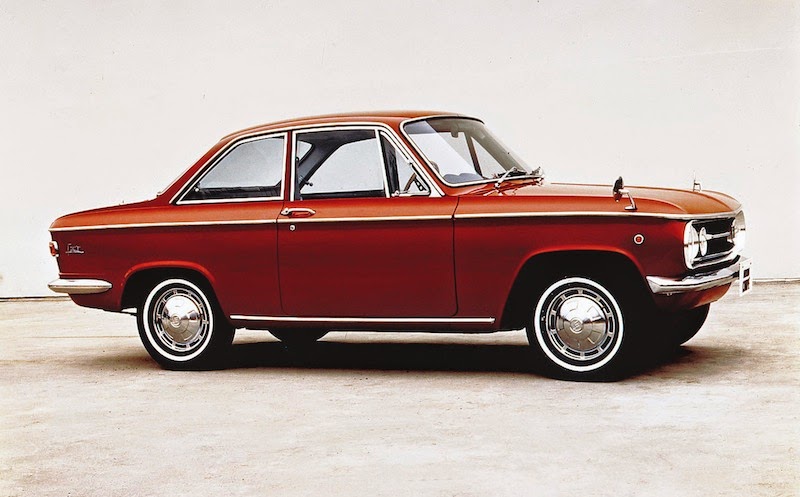Benventui amici!
Mister Benz & Mister Daimler invented the petrol-powered engine & introduced the first motorwagen. Mister Ford invested his life to creating the USAmerican auto industry. Mister Iwasaki introduced the idea of passenger cars to his native Japan. Don Agnelli delivered the world's first mass-produced coach and the city car. The invention of the runabout is, to this fan, one of the most important evolutionary watermarks in automotive history. Making inexpensive people movers frees up money to invest more aggressively into the future of motorcar technology.
In past entries, we've taken a glimpse at the influence of FIATs on other European brands. This week we are considering the influence of FIAT, as well as various Italian engineers & design houses, on Japanese automotive history.
As is the case with most serious contenders to automobile supremacy, Japan has been building automobiles for some time. Europe is the birthplace of the automobile. Japan, obviously, is not in Europe. So, how did this industry develop there? Japanese industrialists sought cooperative relationships with European automakers, of course. The first product resembling a mass-produced coach, to come from this kind of relationship, is that of Mitsubishi Shipbuilding Company and FIAT S.p.A.. Mitsubishi called this creation the Mitsubishi Model A.
Fans of the very earliest FIATs would reckon Japan's first passenger carrier looks a lot like the 1910 FIAT Tipo 3 and they would be 100% correct. The Tipo 3 served as the basis for the Model A. It comes as little surprise the Kobe-based shipping company would be first to produce results from relationships with foreign industrialists, though. Kobe served as Japan's most important port for a very long time.
During the great wars, the Japanese auto market was limited to industrial vehicles. So, the fully formed idea of people movers would not gain real traction, in The Land of the Rising Sun, until after the '50s.
Kei cars… small & cute, but not very practical… served as the first notable Japanese contribution to the automobile industry. Kei cars, like early small FIATs, were designed & marketed to those able to afford a motorbike but unable to afford a proper estate coach. Curiously, many kei cars… such as the Carol… bore many design elements reminiscent of FIATs & Autobianchis.
The idea of the kei car (lightweight automobile) was birthed at the end of WWII. Suzuki and Subaru released two of the earliest examples in 1955 & 1958, respectively. But it was the government mandate to create a larger a/k/a more practical 'national car' that sent automakers back to Europe in the '60s. Enter Toyota, Mitsubishi and, specifically, Mazda.
Mazda, having already contributed the R360 and Carol kei cars, was eager to deliver the all important 'national car' of Japan. To do this, the company enlisted the mighty pen of Giorgetto Giugiaro (then, at Bertone). The enlistment produced the Mazda Familia a/k/a Mazda 323 a/k/a Mazda Protogé. Later, in the '90s, the Familia would be rebadged a Ford Escort for the North American market. The Escort replaced the first generation Fiesta, designed by Ghia designer Tom Tjaarda. The North American compact market, itself, was created by Wisconsin-based Nash. Many Nash models were, of course, designed by Italian design houses (like Pininfarina). With cars, such as the Familia, Japan was officially on the move. Along the way, Italy would make a constant stylistic impression.
In past entries, we've taken a glimpse at the influence of FIATs on other European brands. This week we are considering the influence of FIAT, as well as various Italian engineers & design houses, on Japanese automotive history.
Our beloved 500 brightens the streets of Japan
Is it FIAT or is it Memorex? Mitsubishi Model A
During the great wars, the Japanese auto market was limited to industrial vehicles. So, the fully formed idea of people movers would not gain real traction, in The Land of the Rising Sun, until after the '50s.
Kei cars… small & cute, but not very practical… served as the first notable Japanese contribution to the automobile industry. Kei cars, like early small FIATs, were designed & marketed to those able to afford a motorbike but unable to afford a proper estate coach. Curiously, many kei cars… such as the Carol… bore many design elements reminiscent of FIATs & Autobianchis.
Sweet lil' Carol: Japan Gets Rolling
The idea of the kei car (lightweight automobile) was birthed at the end of WWII. Suzuki and Subaru released two of the earliest examples in 1955 & 1958, respectively. But it was the government mandate to create a larger a/k/a more practical 'national car' that sent automakers back to Europe in the '60s. Enter Toyota, Mitsubishi and, specifically, Mazda.
A dash of Italian: Mazda Familia GS
Subaru 1500: Inspired by Pininfarina's Peugot 403
Datsun/Nissan Sport/Fairlady: A Wink To Italia
Bertoni's Citroën 2CV inspired Toyota: Publica
Honda S500: The first, styled to battle Datsun
Although Japanese automobiles have certainly grown into their own, examples of the longstanding relationship with the Land of the Boot can still be seen and felt. In fact, the relationship continues to evolve. Suzuki and FIAT collaborated on the SX4 & Sedici respectively. FIAT is, most recently, working with Mazda to co-develop the next generation of MX-5 a/k/a Miata (the original inspired by Alfa, FIAT and other European Spiders/Roadsters) as well as the long, eagerly anticipated return of the FIAT Spider.
The Return of the Spiders
Roadways and highways… the world over... look a little sexier, thanks in no small part to the global focus of FIAT and the talented industrial design houses of Italy. So it was written and so it has been done.
Vivere.Amare.Guidare.
Ciao!
@


































